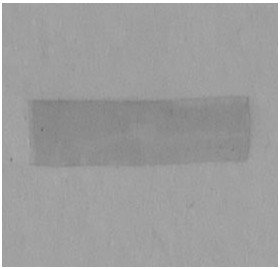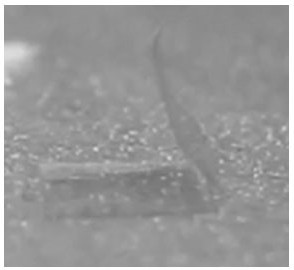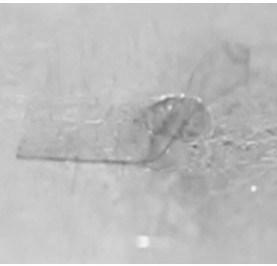A light-colored transparent high-temperature-resistant shape-memory polyimide film material and its preparation method
A technology of polyimide film and high temperature resistance, which is applied in the field of light-colored transparent high temperature resistant shape memory polyimide film material and its preparation, and can solve unsatisfactory, poor, glass transition temperature below 300°C , Reduce the heat resistance of polymers and other issues, achieve excellent optical properties, improve heat resistance, and improve optical properties
- Summary
- Abstract
- Description
- Claims
- Application Information
AI Technical Summary
Problems solved by technology
Method used
Image
Examples
Embodiment 1
[0032] (1) At room temperature, add 0.6404 g of 2,2'-bis(trifluoromethyl)-4,4'-diaminobiphenyl, 0.8884 g of Hexafluorodianhydride was dissolved by adding 8.6 ml DMAc, stirred and reacted at room temperature for 8 h to obtain a PAA solution;
[0033] (2) Place the PAA solution at room temperature for 12 h for defoaming;
[0034] (3) Coat the defoamed solution on the glass substrate and place it in an oven for thermal imidization. The heating program is 60°C (1h), 80°C (1h), 100°C (1h), 200°C ( 1h), 300°C (1h), to obtain a polyimide film.
Embodiment 2
[0036] (1) At room temperature, add 0.6084 g of 2,2'-bis(trifluoromethyl)-4,4'-diaminobiphenyl, 0.8974 g of Hexafluorodianhydride and 0.0288 g of octaaminosilsesquioxane were dissolved in 8.6 ml of DMAc, stirred and reacted at room temperature for 8 h to obtain a PAA solution;
[0037] (2) Place the PAA solution at room temperature for 12 h for defoaming;
[0038] (3) Coat the defoamed solution on the glass substrate and place it in an oven for thermal imidization. The heating program is 60°C (1h), 80°C (1h), 100°C (1h), 200°C ( 1h), 300°C (1h), to obtain a polyimide film.
Embodiment 3
[0040] (1) At room temperature, add 0.5764 g of 2,2'-bis(trifluoromethyl)-4,4'-diaminobiphenyl, 0.8974 g of Hexafluorodianhydride and 0.0576 g of octaaminosilsesquioxane were dissolved in 8.6 ml of DMAc, stirred and reacted at room temperature for 8 h to obtain a PAA solution;
[0041] (2) Place the PAA solution at room temperature for 12 h for defoaming;
[0042] (3) Coat the defoamed solution on the glass substrate and place it in an oven for thermal imidization. The heating program is 60°C (1h), 80°C (1h), 100°C (1h), 200°C ( 1h), 300°C (1h), to obtain a polyimide film.
PUM
| Property | Measurement | Unit |
|---|---|---|
| glass transition temperature | aaaaa | aaaaa |
| glass transition temperature | aaaaa | aaaaa |
| glass transition temperature | aaaaa | aaaaa |
Abstract
Description
Claims
Application Information
 Login to View More
Login to View More - R&D
- Intellectual Property
- Life Sciences
- Materials
- Tech Scout
- Unparalleled Data Quality
- Higher Quality Content
- 60% Fewer Hallucinations
Browse by: Latest US Patents, China's latest patents, Technical Efficacy Thesaurus, Application Domain, Technology Topic, Popular Technical Reports.
© 2025 PatSnap. All rights reserved.Legal|Privacy policy|Modern Slavery Act Transparency Statement|Sitemap|About US| Contact US: help@patsnap.com



